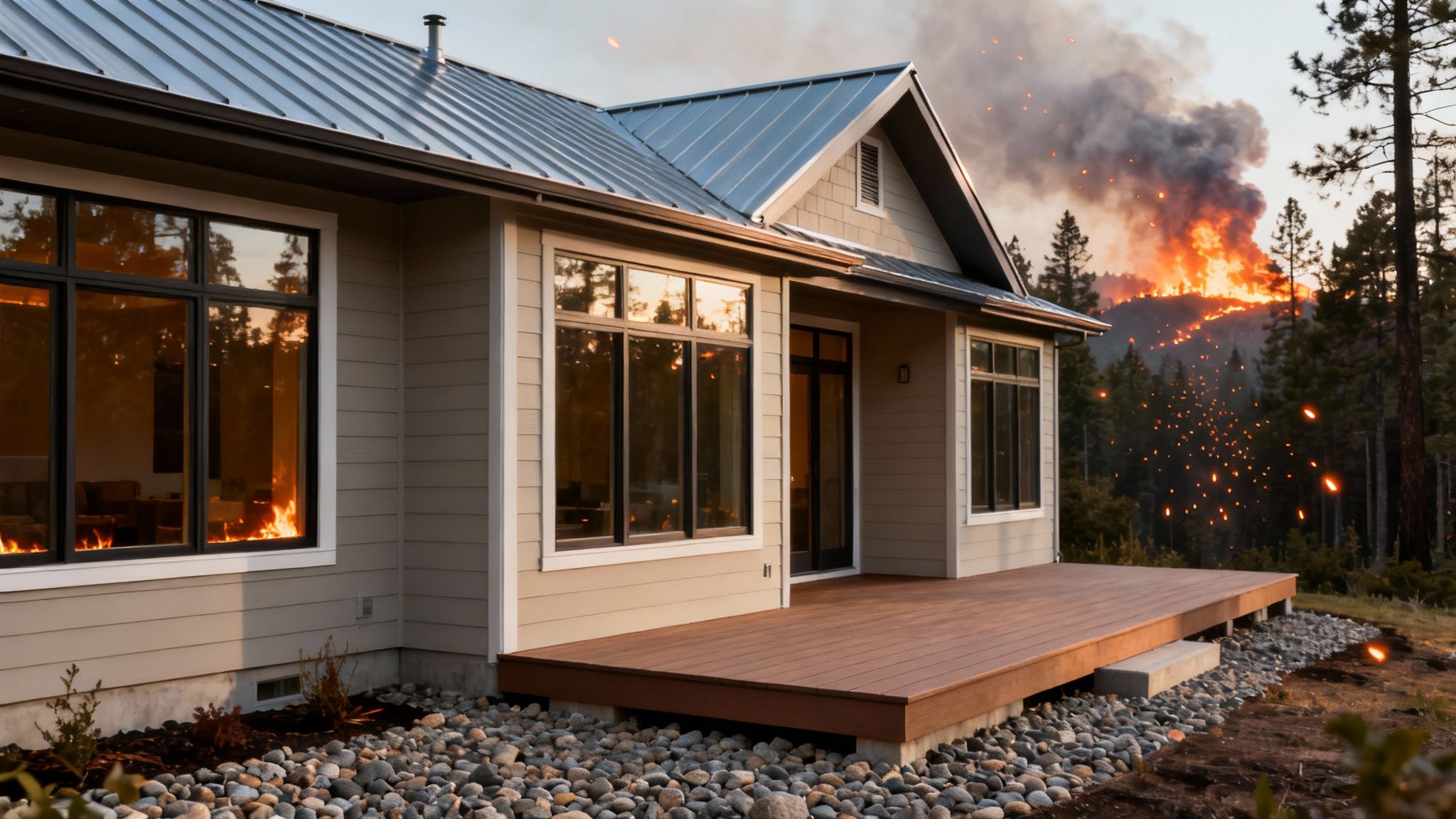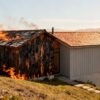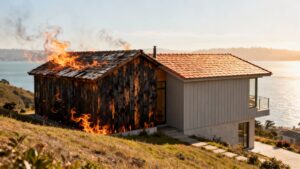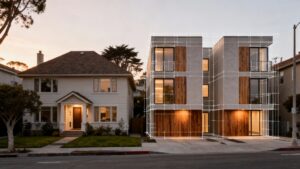In the Bay Area, building a home that stands up to wildfires is about making smart material choices. This approach is called resilient by design. It means choosing roofing, siding, and windows that resist ignition from embers and intense heat.
This strategy changes a house from a potential victim into a structure engineered for California's wildfire threat. It’s about building in safety from the start.
Why Resilient Design Is Your Best Defense Against Wildfire
Living in communities like Berkeley, Oakland, and the surrounding hills means facing the reality of wildfires. As a result, construction is shifting from reacting after a disaster to building resilience from the ground up. True safety is the result of careful planning and material selection.
This guide is for builders, architects, and homeowners in the Bay Area who understand a home's best defense is its own structure.
Think of a resilient by design approach as an insurance policy built into your walls. It goes beyond minimum building codes. It recognizes that a home’s survival often depends on its ability to resist ignition from wind-blown embers, which cause up to 90% of homes lost in these events.
Building for Resilience and Sustainability
Resilient design and sustainable building are a natural fit. Sustainability focuses on energy efficiency, while resilience adds durability against natural disasters. A home that survives a wildfire is inherently sustainable, preventing the huge cost of rebuilding. You can learn more about how these ideas work together by exploring what sustainable building means for Bay Area construction.
Putting this proactive mindset into practice involves a few key steps:
- Know Your Local Risks: Understand the specific threats in Bay Area Wildland-Urban Interface (WUI) zones.
- Prioritize the Exterior Shell: Focus on the roof and siding as your primary shield.
- Secure the Weak Points: Reinforce windows, doors, and vents to block embers and heat.
- Create Defensible Space: Use non-combustible materials like stone near the home to reduce fuel.
By making these choices, you aren't just building a house; you're creating a defense. Selecting the right fire-rated materials is the most important investment for your property's future.
Your Home's First Line of Defense: Roofing and Siding
When a wildfire approaches, it brings a storm of burning embers that can travel for miles. Your home's first and most critical shield is its exterior. The roofing and siding you choose act as armor against these embers.
The goal is to wrap your home in a shell that refuses to burn. This strategy starts with the roof. As the largest exposed surface, it's the main landing zone for embers, making it the most vulnerable part of your home.
This graphic shows the shift from simply reacting to a wildfire to proactively building a home that's resilient by design.
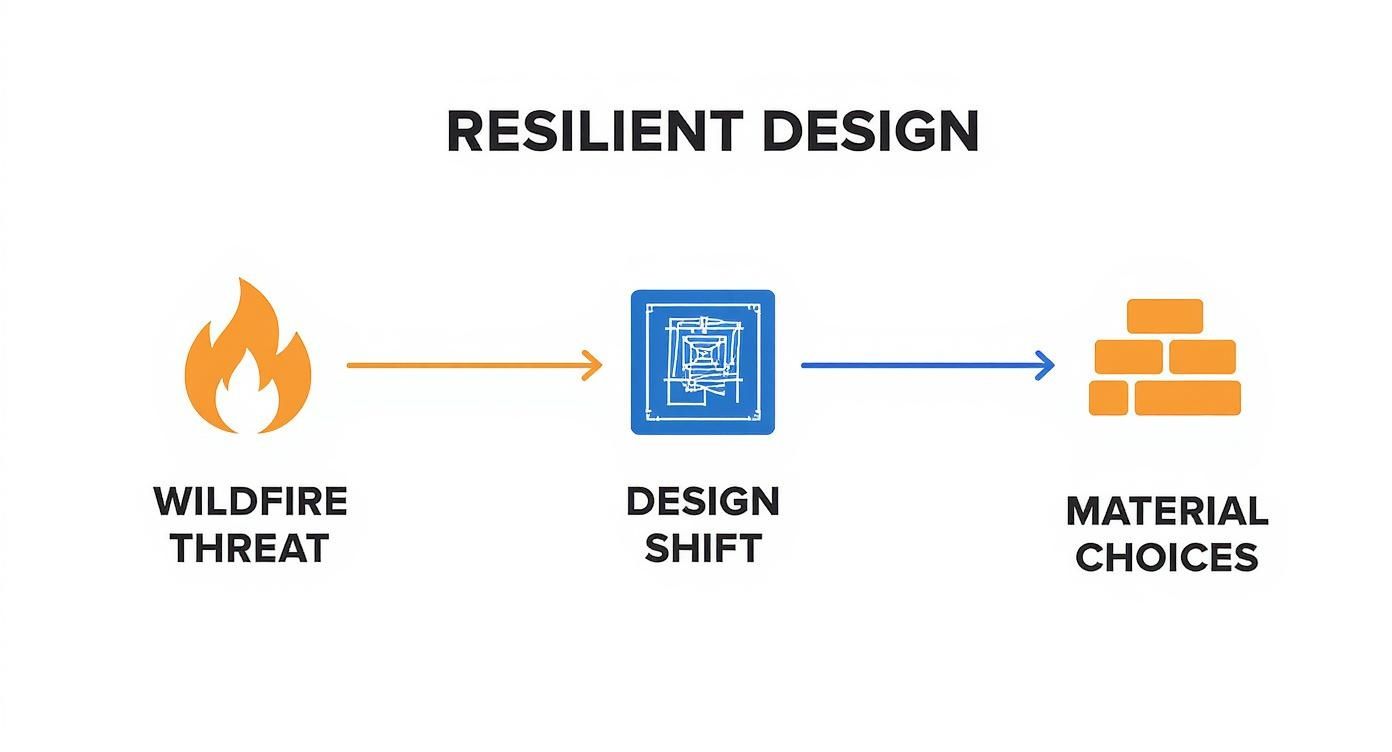
As you can see, resilient construction is an active approach. It involves making smart choices in materials and design to create a powerful defense.
Choosing a Class A Fire-Rated Roof
In wildfire-prone areas like the Berkeley and Oakland hills, building codes require a Class A fire-rated roof. This standard certifies that a material can withstand a severe fire test without catching flame. It's the highest rating available.
Let's break down some top Class A options we see on Bay Area homes:
- Composite Shingles: Modern composite shingles are made with fire-retardant granules for excellent protection. They can look like classic wood shake but offer far better fire resistance.
- Metal Roofing: A standing seam metal roof is a great investment for fire resilience. It is completely non-combustible and sheds flammable debris like pine needles.
- Tile (Clay or Concrete): Tile is a classic California choice because it's naturally fireproof. However, professional installation is key to prevent gaps where embers could get trapped.
Choosing a Class A roof is one of the most impactful decisions a homeowner or builder can make. Studies show that wind-driven embers cause up to 90% of home ignitions during wildfires, making the roof your most critical defense.
Selecting Ignition-Resistant Siding
Your walls need as much protection as your roof. The siding must resist both intense radiant heat and direct contact from embers. While wood siding can be fuel, modern alternatives provide a non-combustible barrier.
These materials are champions of fire-resistant construction. They create a hardened shell that stops flames from reaching the home's framing.
To help you navigate the options, here is a quick comparison of the most common fire-resistant materials we recommend for projects in Berkeley and Oakland.
Comparing Fire-Resistant Exterior Materials
| Material | Fire Rating | Key Benefits | Best For |
|---|---|---|---|
| Metal | Class A | Non-combustible, durable, low maintenance, sheds debris easily. | Modern and rustic designs; areas with heavy leaf or pine needle fall. |
| Fiber Cement | Class A | Non-combustible, resists rot and pests, versatile appearance. | Mimicking traditional wood siding in high-risk WUI zones. |
| Stucco | Non-combustible | Seamless, durable, classic California look, no joints for embers. | Spanish, Mediterranean, and contemporary architectural styles. |
| Composite Shingles | Class A | Cost-effective, wide variety of styles and colors, easy installation. | Homeowners wanting a traditional look with modern fire protection. |
| Clay/Concrete Tile | Class A | Extremely durable, long lifespan, inherently fireproof. | Homes where long-term durability and a classic aesthetic are priorities. |
Each material offers a fantastic line of defense. The best choice often depends on the home's architectural style, the surrounding environment, and your project budget.
Leading Siding Materials for Wildfire Zones
For builders and architects in the Bay Area, the right siding balances code compliance, durability, and aesthetics. Two materials consistently stand out for creating a fire-safe exterior:
- Fiber Cement Siding: Made from sand, cement, and cellulose fibers, this material is non-combustible. It won’t ignite from flame and resists warping from heat, making it a top choice for WUI zones.
- Stucco: A California classic for a reason. A traditional three-coat stucco application creates a seamless, thick, and highly fire-resistant barrier.
You can find many profiles and finishes in these materials to meet any design goal. For a deeper dive into specific options, check out our high-quality moulding, trim, and siding selections. Pairing a Class A roof with ignition-resistant siding creates a strong defense for your home.
Securing Vulnerable Points with Fire-Rated Windows and Doors
Think of your home's walls as armor. But even the best armor is useless if it has a weak spot. During a wildfire, windows and doors are often those critical weak spots. Intense heat can shatter standard glass and ignite wood frames, letting fire inside.
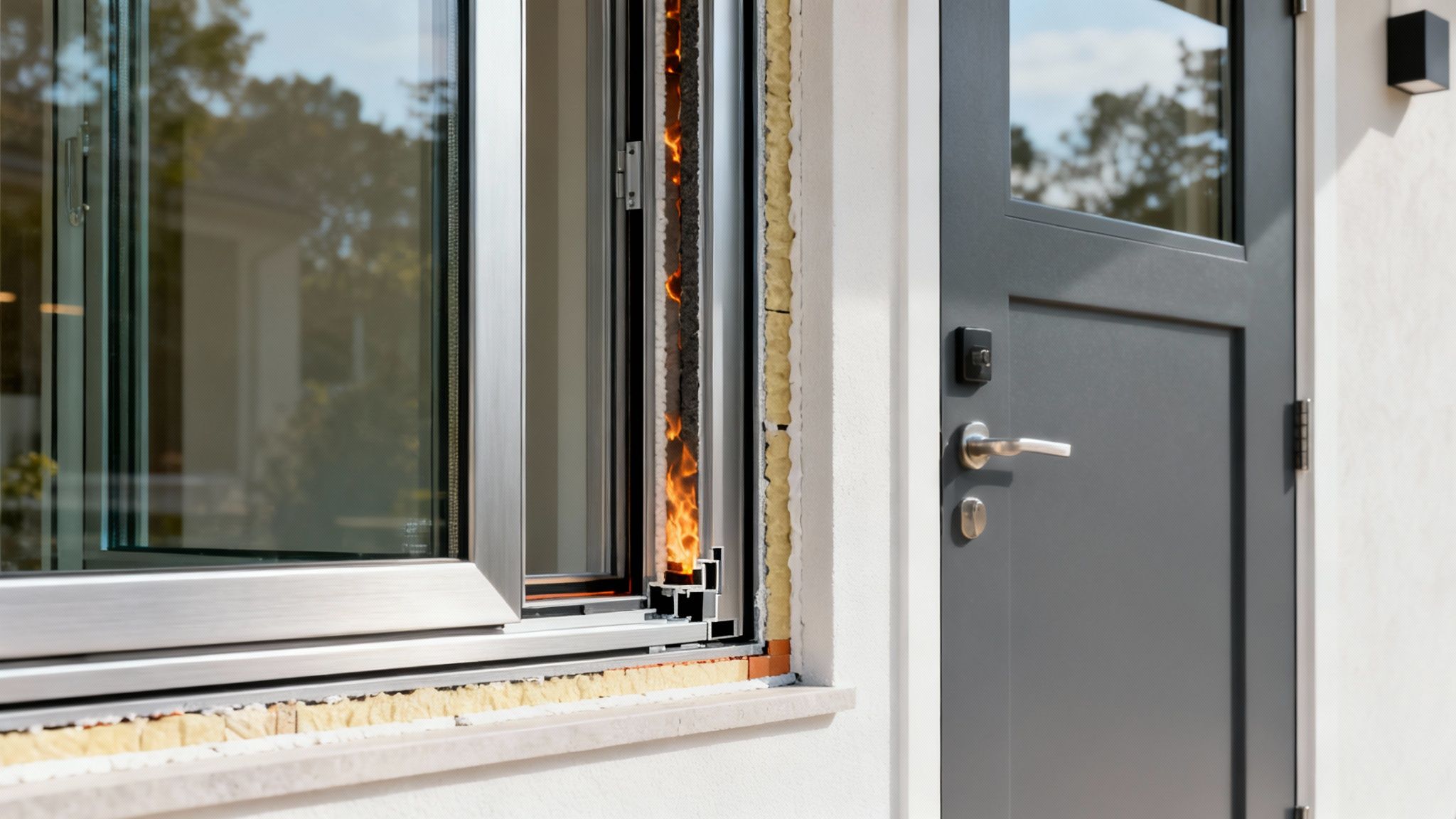
This is why choosing the right windows and doors is a crucial step in creating a resilient home. Modern engineering has produced incredible advancements that turn these entry points into fortified defenses.
Why Tempered Glass Is Non-Negotiable
The biggest threat to a window during a wildfire is often radiant heat. This intense energy can cause standard glass to shatter. This leaves a hole for embers to fly through.
This is where tempered glass comes in. It's a non-negotiable part of building a wildfire-ready home in the Bay Area.
Created through a special heating and cooling process, tempered glass is about four times stronger than regular glass. More importantly, it can handle extreme temperature swings without failing.
In Wildland-Urban Interface (WUI) zones, California building codes mandate that at least one pane of a dual-pane window must be tempered glass. This one requirement dramatically boosts a home's ability to resist both heat and ember intrusion.
The Power of Multi-Pane Glazing
The construction of the window unit also plays a huge role. Dual-pane windows create an insulating air gap between the panes. This gap acts as a powerful thermal shield.
For Bay Area homes, this design offers serious benefits:
- Slows Heat Transfer: The air gap reduces how much radiant heat gets through the window. This can prevent items like curtains from catching fire.
- Provides Redundancy: If the outer pane is compromised by debris, the inner pane remains as a last defense against embers.
- Enhances Energy Efficiency: The same design that blocks wildfire heat also keeps your home cooler in summer and warmer in winter.
Frame Materials That Resist Ignition
The glass is only half the battle; the window frame is just as important. A standard wood frame can eventually become fuel when exposed to intense heat. This is why modern, fire-resistant frames are essential.
Leading manufacturers like Marvin and Andersen have product lines designed for high-risk areas. Their best solutions use composite or clad materials that resist ignition. Taking the time to explore the options for quality windows in the East Bay is well worth it.
Here are the top material choices for window and door frames in WUI zones:
- Fiberglass: This material is incredibly stable and strong. It resists heat and won't warp, melt, or burn easily.
- Aluminum-Clad Wood: This option gives you the beauty of a wood interior with a durable aluminum exterior. The cladding shields the wood from heat and embers.
The Final Seal: Professional Installation
Finally, remember that even the best fire-rated window will fail if installed incorrectly. Professional installation ensures there are no tiny gaps where embers can sneak through. A tight seal is the final, critical step in hardening these vulnerable points.
By combining tempered, multi-pane glass with ignition-resistant frames and ensuring an expert installation, you create a robust barrier. This integrated approach is fundamental to building a home that can withstand a Bay Area wildfire.
Extending Resilience Beyond Your Home's Walls
A truly fire-safe property includes the house and its surrounding landscape. A home can have the best fire-rated roof and windows, but a flammable deck attached to it remains a critical vulnerability.
Extending your fire-wise strategy beyond your walls turns your yard into part of your home's defense. This approach starts with the deck. Old wood decks can act like kindling when embers land on them.
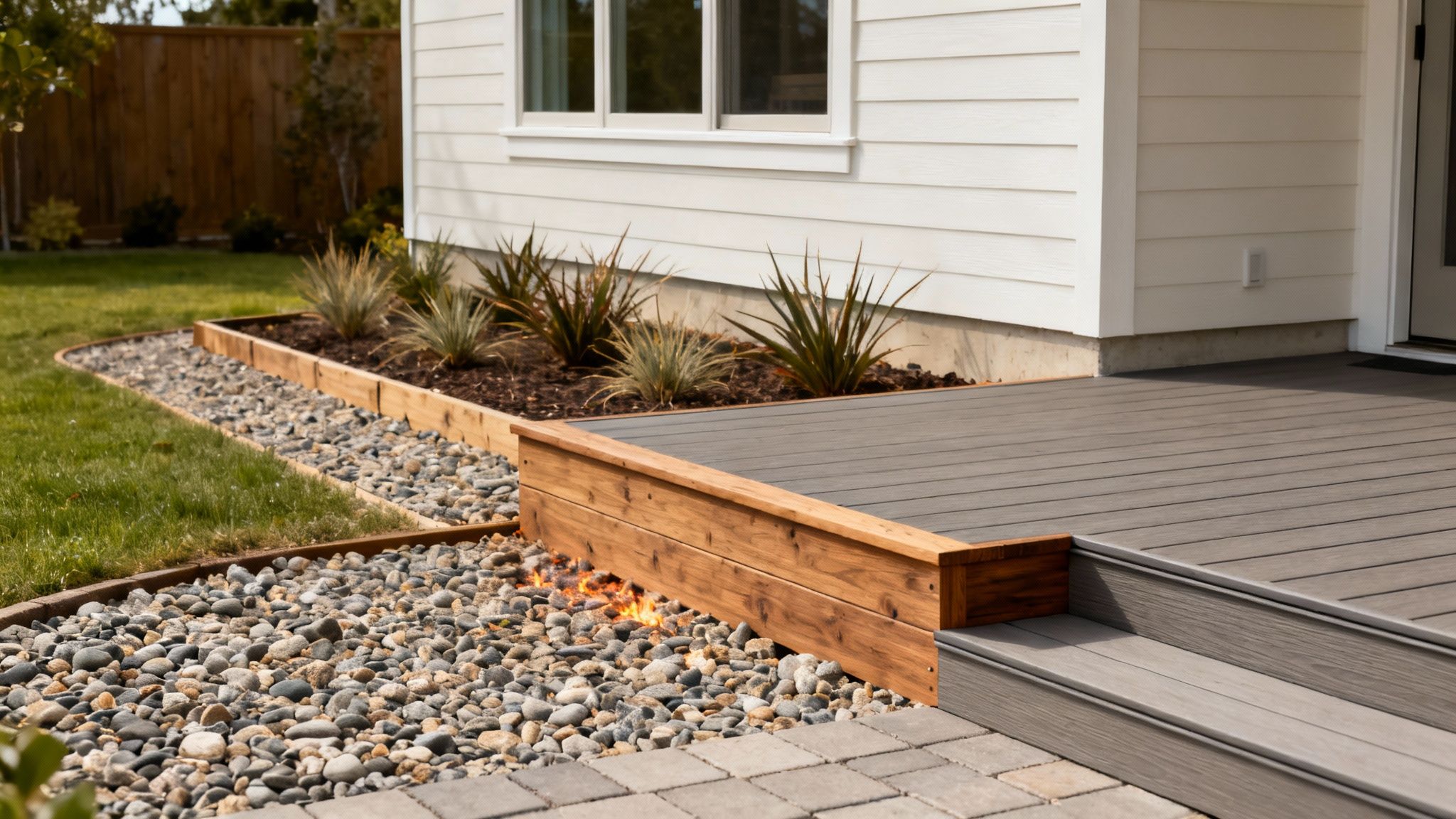
Upgrading Your Deck for Fire Safety
In a wildfire, a deck can carry fire directly to your home's siding. To break this chain, builders and homeowners across the Bay Area are using materials that resist ignition.
These modern alternatives give you the beauty of a classic deck without the fire risk. They are a cornerstone of any resilient by design strategy.
Here are the top choices for wildfire-ready decking:
- Composite Decking: Made from wood fibers and recycled plastics, these boards are less flammable than traditional lumber. Many brands offer products with a Class A or Class B fire rating.
- Fire-Retardant-Treated (FRT) Lumber: For those who love the look of real wood, FRT lumber is the ideal solution. It is pressure-treated with fire-inhibiting chemicals that drastically reduce its flammability.
Creating a Non-Combustible Zone
Beyond the deck, the most important landscape concept is creating defensible space. This is a buffer zone around your home to slow or stop a wildfire. The most critical area is the first five feet from your home's foundation, which should be free of flammable materials.
This five-foot perimeter is often called the "ember-resistant zone." The goal is to create an area where embers land on nothing that can ignite. This is a simple but powerful defensive tactic.
To achieve this, use non-combustible materials for walkways and patios next to the house. This hardscaping acts as a firebreak.
Great material choices for this zone include:
- Gravel or crushed stone
- Concrete pavers
- Brick or flagstone patios
- Poured concrete walkways
The investment in rebuilding homes to these standards has a massive economic benefit. Making them wildfire-resistant from the start could prevent billions in future losses. You can learn more about how rebuilding to code saves billions in research from Headwaters Economics.
By thoughtfully selecting decking materials and using hardscaping, you build layers of protection. This approach ensures your entire property works together to defend against wildfire.
Building a Fire-Resistant Core with Modern Framing and Insulation
We’ve covered the home's outer shell—the roof, siding, and windows. But for a home to be truly resilient, especially in high-risk fire zones across the Bay Area, we need to look at its structural skeleton.
What holds a house up during a fire is critical. Traditional wood framing is strong, but it's also fuel. Thankfully, modern alternatives can give a home a non-combustible core.
The Strength of Steel Framing
For anyone building in a WUI zone, cold-formed steel (CFS) framing is a smart upgrade. It gives the house a skeleton that can't burn. Unlike wood, steel adds no fuel to a fire and won’t warp under intense heat.
That fire resistance makes CFS a game-changer. It provides both safety and efficiency on the job site. You can brush up on the basics with our guide on how to frame a wall.
The benefits don't stop at fire safety. CFS-framed homes can be built faster and may even earn you a break on insurance premiums.
The experts at BuildSteel.org point to cold-formed steel as a leading strategy for wildfire resilience. Homes built with CFS framing not only assemble 40% faster but can also qualify for insurance premium discounts of up to 20%. You can learn more about how CFS is leading the way in fire-resilient homes on BuildSteel.org.
Insulation: The Unseen Hero of Fire Safety
Insulation inside your walls is another critical player. The right kind of insulation also acts as a fire-blocking barrier.
By slowing heat transfer through wall cavities, fire-resistant insulation protects the structural framing. This can buy precious time during a wildfire. That delay can be the difference between a damaged home and a total loss.
Top Choices for Fire-Resistant Insulation
For projects in Berkeley, Oakland, and other Bay Area communities, two insulation materials stand out:
- Mineral Wool: Made from melted rock and slag, it’s naturally non-combustible. Mineral wool can handle temperatures over 1,800°F without melting or creating toxic smoke.
- Fiberglass: Made from fine glass fibers, fiberglass is also non-combustible. It won’t burn or support the spread of flames. High-density fiberglass batts offer excellent thermal protection and fire resistance.
When you use these materials, you’re not just building an energy-efficient home. You’re building one that’s tough from the inside out.
Partnering With Experts to Build Your Wildfire-Ready Home
Building a wildfire-ready home in the Bay Area is an achievable goal. The power is in the materials you choose for every part of your project. When you use Class-A roofing, ignition-resistant siding, and tempered glass windows, you're making a smart, proactive choice.
Of course, turning plans into reality means finding a partner who understands our local challenges. Selecting the right professionals is just as critical as selecting the right materials. Our guide on how to choose a contractor can help you find qualified builders who understand wildfire-ready construction.
Your Local Material Specialists
Navigating building codes for WUI zones in places like Berkeley or Oakland can be overwhelming. This is where an expert partner makes all the difference. They bring clarity, ensuring every product meets local codes and fits your design vision.
The demand for these solutions is growing fast. In 2025, the global market for building fireproof materials is projected to grow significantly. This growth is driven by stricter building codes that now require fire-resistant materials. You can discover more about this market trend.
Building a home that is resilient by design is the most effective insurance policy you can invest in. It’s a proactive choice that safeguards your property, your family, and your peace of mind against the increasing threat of wildfires in California.
We invite you to talk with the specialists here at Truitt & White. Our team has deep, hands-on knowledge of Bay Area WUI codes and how products perform in the real world. We're here to help you navigate your project with confidence.
Visit our Berkeley showroom to get personalized recommendations and start building your wildfire-ready home today.
Frequently Asked Questions About Wildfire-Ready Construction
Building in the Bay Area means thinking about wildfire resilience. Here are clear answers to the most common questions we hear from builders, architects, and homeowners in Berkeley and Oakland.
Does fire-resistant construction cost a lot more?
Building a new home to wildfire-resistant standards typically adds less than 10% to the total project cost. In some cases, the price is very similar to conventional construction. This investment often pays for itself through lower insurance premiums and reduced maintenance.
Can I make my existing Bay Area home more fire-resistant?
Yes, you can. You don't have to start from scratch to improve your home's defenses. Key retrofits include replacing an old roof with a Class A system, installing ember-resistant vents, and upgrading windows to tempered glass.
What is the single most important part of a house to protect from wildfire?
The roof is the most vulnerable part of any home during a wildfire. Its large surface is the perfect landing spot for embers, which cause most home ignitions. Upgrading to a Class A fire-rated roofing system is the most critical step you can take.
How do I know if my property is in a Wildland-Urban Interface (WUI) zone?
Your local city or county planning department is the best source for this information. Departments in places like Berkeley or Alameda County have official WUI zone maps on their websites. It's important to check your property's status before starting a project.
Can I still use wood and be fire-resistant?
Yes, you can. If you love the classic look of wood, fire-retardant-treated (FRT) lumber is a great option. This wood is pressure-treated with chemicals that make it far more resistant to ignition. FRT wood allows you to have a traditional aesthetic while meeting strict Bay Area fire codes.
Building a home that is truly resilient by design comes down to using the right materials and having expert guidance. The team at Truitt & White has the local knowledge and product expertise to help you make confident, informed decisions for your next project.


